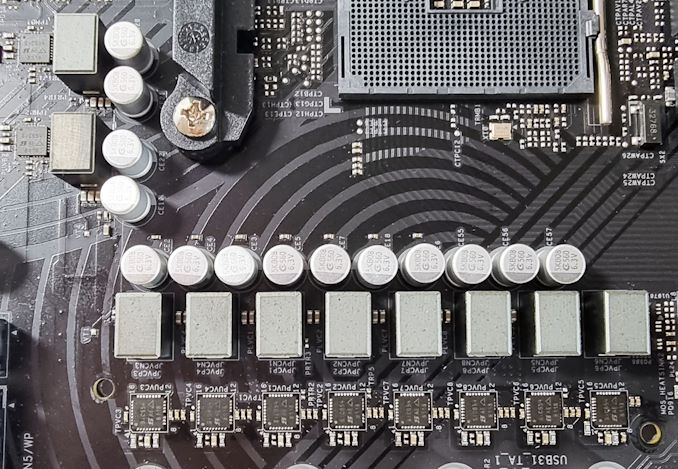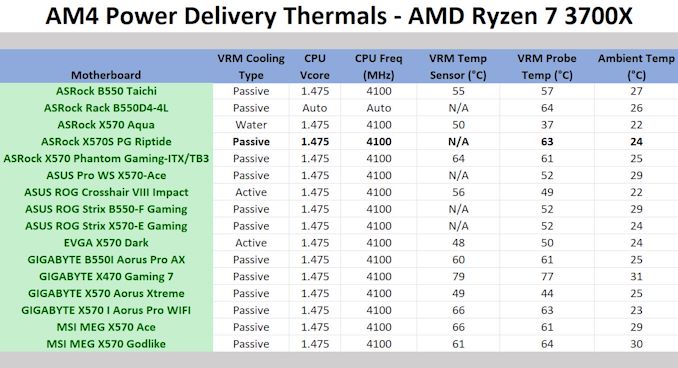The ASRock X570S PG Riptide Motherboard Review: A Wave of PCIe 4.0 Support on A Budget
by Gavin Bonshor on October 22, 2021 9:00 AM ESTPower Delivery Thermal Analysis
One of the most requested elements of our motherboard reviews revolves around the power delivery and its componentry. Aside from the quality of the components and its capability for overclocking to push out higher clock speeds which in turn improves performance, is the thermal capability of the cooling solutions implemented by manufacturers. While almost always fine for users running processors at default settings, the cooling capability of the VRMs isn't something that users should worry too much about, but for those looking to squeeze out extra performance from the CPU via overclocking, this puts extra pressure on the power delivery and in turn, generates extra heat. This is why more premium models often include heatsinks on its models with better cooling designs, heftier chunks of metal, and in some cases, even with water blocks.

The 10-phase (8+2) power delivery operating at 4+2 on the ASRock X570S PG Riptide
Testing Methodology
Out method of testing out if the power delivery and its heatsink are effective at dissipating heat, is by running an intensely heavy CPU workload for a prolonged method of time. We apply an overclock which is deemed safe and at the maximum that the silicon on our AMD Ryzen 7 3700X processor allows. We then run the Prime95 with AVX2 enabled under a torture test for an hour at the maximum stable overclock we can which puts insane pressure on the processor. We collect our data via three different methods which include the following:
- Taking a thermal image from a birds-eye view after an hour with a Flir Pro thermal imaging camera
- Securing two probes on to the rear of the PCB, right underneath CPU VCore section of the power delivery for better parity in case the first probe reports a faulty reading
- Taking a reading of the VRM temperature from the sensor reading within the HWInfo monitoring application
The reason for using three different methods is that some sensors can read inaccurate temperatures, which can give very erratic results for users looking to gauge whether an overclock is too much pressure for the power delivery handle. With using a probe on the rear, it can also show the efficiency of the power stages and heatsinks as a wide margin between the probe and sensor temperature can show that the heatsink is dissipating heat and that the design is working, or that the internal sensor is massively wrong. To ensure our probe was accurate before testing, I binned 10 and selected the most accurate (within 1c of the actual temperature) for better parity in our testing.
For thermal image, we use a Flir One camera as it gives a good indication of where the heat is generated around the socket area, as some designs use different configurations and an evenly spread power delivery with good components will usually generate less heat. Manufacturers who use inefficient heatsinks and cheap out on power delivery components should run hotter than those who have invested. Of course, a $700 flagship motherboard is likely to outperform a cheaper $100 model under the same testing conditions, but it is still worth testing to see which vendors are doing things correctly.
Thermal Analysis Results

We measured 57.7°C on the hottest part of the CPU socket during our testing
The ASRock X570S PG Riptide is using a 10-phase power delivery, which is split into an 8-phase design for the CPU VCore, and a 2-phase setup for the SoC. The CPU section is using eight Vishay SIC654 50 A power stages operating with two UPI UP1911R smart PWM doublers that are quadrupling the power stages in a 4+0 configuration. The SoC is using two independent Vishay SIC654 50 A power stages, with a UPI UP9595S PWM controller operating in 4+2 mode. Cooling the power delivery is a single heatsink that doubles up as the board's rear panel cover. It's not very weighty and relies on good passive airflow over a large plate over the top of the heatsink.
Looking at how the ASRock X570S PG Riptide performed in our thermal VRM testing, it did pretty well considering it's an entry-level to mid-ranged X570(S) model. We measured a temperature of 63°C from our K-type thermocouple and got a reading of 57.7°C from the hottest part of the CPU socket area when using our FLIR thermal imaging camera. Unfortunately, the PG Riptide doesn't use an integrated VRM thermal sensor.
Comparing the PG Riptide to other AM4 models we've previously tested, it does sit near the warmer boards we've tested, but it's still well within specifications and performs as expected given the price point the board sits at.











39 Comments
View All Comments
meacupla - Saturday, October 23, 2021 - link
You are either clueless or a total moron, but I'll give you the benefit of the doubt of being the former.The CPU socket, RAM slots, m.2 slots, and pci-e slots do not add much to the BoM on mobos
In fact, you can buy Intel LGA 115x and 2011 sockets off of Ali express for pennies.
Soldering everything to the mobo adds to the complexity, which means, it will, in fact, be more costly to manufacture.
Not only that, instead of having a single SKU for the mobo, you are now adding more SKUs for different configurations. This means you need more assembly lines building each of the SKUs, and are further increasing cost to manufacture.
The only reason why apple is capable of soldering everything onto the board, is because
1. They have a very small niche market, which is around 7.4% of the worldwide PC market share.
2. Their very small niche market doesn't seem to care how their PC can't be upgraded or repaired.
3. Their very small niche market doesn't seem to care how expensive Macs cost.
Also, how the hell did you arrive at the conclusion, "Apple is cheaper, because they solder everything to the mobo"?
Wrs - Saturday, October 23, 2021 - link
Sockets always add to product cost, but then so do multiple SKUs, in terms of inventory management. The added costs may be minimal when done well, but technically I don't see how soldering a chip directly to board can be higher BOM than soldering the socket and then inserting the same chip later. You are aware that sockets have to be soldered to board, right? :)And Apple ain't small. 7.4% share is still 20 million units each year, plus they share techniques & components with the miniature boards in another 150-200 million phones. Assembly line logistics & just-in-time manufacturing are kind of Apple's superpowers. Swapping one component for another of the same size on the same assembly line ought to be trivial.
meacupla - Saturday, October 23, 2021 - link
Yeah, and then, when you have to do this exact same, multiple SKU thing for the Asrock X570 lineup, which consists of...X570 AQUA
X570 Creator
X570 Taichi Razer Edition
X570 Taichi
X570 Extreme4 Wifi ax
X570 Extreme4
X570 Pro4
X570M Pro4
X570 Steel Legend Wifi ax
X570 Steel Legend
X570 PG Velocita
X570S PG Riptide
X570 Phantom Gaming X
X570 Phantom Gaming 4 Wifi ax
X570 Phantom Gaming 4
X570 Phantom Gaming-ITX/TB3
And combine most of those mobos with the Ryzen 5000 series lineup, which consists of...
Ryzen 9 5950X
Ryzen 9 5900X
Ryzen 7 5800X
Ryzen 5 5600X
Ryzen 7 5700G
Ryzen 5 5600G
Ryzen 3 5300G
Oh, and we can't forget RAM and SSDs, since those too will be soldered on in various configurations.
So, for RAM we will do 8/16/32/64
And for SSD, we will do 128/256/512/1TB/2TB
16 x 7 x 4 x 5 = 2240 possible SKUs
And this will be PURELY from Asrock's lineup. We haven't even done Asus, Gigabyte or MSI yet.
It's pretty easy to see there is going to be a bit of an issue.
Qasar - Saturday, October 23, 2021 - link
imagine this, but change it for intel. 2240 for amd ? i dont even want to consider this for intel. at the store i go to, there are 23 intel cpus ! just swapping cpus, while leaving everything else the same is 7,360 !!!!!!!!!!!!!!!!!!!!!!!!!!!!!!!yea this would NOT work at all.
Wrs - Saturday, October 23, 2021 - link
All that said I agree with your implied stance that we should keep major sockets on the desktop - RAM, CPU, GPU, storage - for the plain fact that the factories to solder/desolder the stuff are so far away, and we need a local ability to customize our stuff and upgrade/fix our components piecemeal.Arbie - Saturday, October 23, 2021 - link
"You are either clueless or a total moron"Do you pay extra, meaculpa, for being gratuitously insulting? Or maybe you think flame wars improve a forum, and would like to be treated that way yourself.
meacupla - Saturday, October 23, 2021 - link
I aim to please.TheinsanegamerN - Saturday, October 23, 2021 - link
Well someone has to tell idiots they are idiots, otherwise they'll try to fly off of the empire state building thinking they've invented flight.Oxford Guy - Saturday, October 23, 2021 - link
1. Except for the employees (including people being paid to astroturf and such by their firms), all people who post here can automatically be characterized as not being geniuses. Geniuses typically have better things to do with their time and are able to recognize that.2. Among the group of less intelligent folk who do post here 'altruistically', each person has a different knowledge base and a different age. Expecting everyone to know everything is foolish. Some overreach in their posts but lack the knowledge to know that. That includes people who preen and pose whilst mocking others' efforts. When people make erroneous claims all that's needed is a simple factual correction, not a narcissistic display of bravura.
Bottom line is this: Worry about yourself first. Worry about your factuality first. When correcting others, do it politely — especially when the people making the posts aren't being paid to do it. Correcting in a bullying manner is its own forum error, one deserving of correction.
Culturally, it is clear that Internet discourse is becoming less civil. I have seen forums devolve, even those that don't have mechanisms (like downvoting and post hiding) that encourage the aggression that causes that devolution. I am not a sociologist so I don't know enough to be able to explain (with less guesswork and more facts) the origins of all of this trend but it is one that I can see clearly in many places — even though pockets of rudeness have always been around. Attention spans seem to be shrinking and with that there seems to be a proportionate rise in entitled smirky wrath.
One thing humanity desperately needs is mandatory curriculum in all schools for understanding fallacies — how to avoid using them in discourse in particular. That would go a long way toward restoring some level of efficiency in public Internet-based communication. Even huge corporations use naked crass fallacies in court (as Sony did when trying to attack consumers who opposed the decision to retroactively strip the PS3 of Linux support).
haakon_k - Sunday, October 24, 2021 - link
Post of the month! Nearly post of the year !! Well said, 'Oxford Guy'.